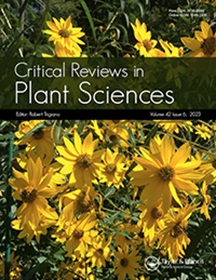成花素激活复合物在水稻开花控制中的意义
IF 4.9
2区 生物学
Q1 PLANT SCIENCES
引用次数: 0
摘要
产量潜力、株高和开花时间是决定水稻生产力的三类性状。水稻的抽穗在很大程度上取决于对环境变化的准确测量,特别是对日照时间和温度的测量。在这篇综述中,我们讨论了所有与抽穗期有关的基因。成花素Hd3a或RFT1的积累是水稻抽穗的关键因素。成花素在水稻叶片中发现,然后输送到茎尖分生组织(SAM),在那里发生成花。我们讨论了14-3-3和FD1蛋白形成成花素激活复合物(FAC)以诱导开花基因的表达。此外,本文还介绍了与抽穗期相关的两个关键途径,GI-Hd1-Hd3a和Ghd7-Ehd1-Hd3a/RFT1。我们总结了具有组蛋白修饰功能的蛋白质,由于组蛋白的修饰对抽穗期也有重要意义。开花时间也极为依赖于环境,包括营养物质的可用性、非生物和生物胁迫,我们还认为在不同的极端环境下水稻抽穗期的表型也是如此。最后,我们收集了据报道在抽穗期发生变化的基因,但它们的详细分子调控仍然难以捉摸。因此,本文系统地介绍了抽穗期,为研究者进一步研究抽穗期表型提供了知识和思路。本文章由计算机程序翻译,如有差异,请以英文原文为准。
The Significance of Florigen Activation Complex in Controlling Flowering in Rice
Abstract Yield potential, plant height and flowering time are three classes of traits that determine the productivity of rice. Rice heading greatly depends on the accurate measurement of environment changes, particularly in day length and temperature. We discuss all genes reported to be related to the heading time in this review. The accumulation of florigen, such as Hd3a or RFT1, is the key factor for rice heading. Florigen is found in the rice leaf and then transports into the shoot apical meristem (SAM), where floral initiation occurs. We discuss the formation of florigen activation complex (FAC) with 14-3-3 and FD1 proteins to induce the expression of flowering genes. In addition, two key pathways related to heading date, GI-Hd1-Hd3a and Ghd7-Ehd1-Hd3a/RFT1 are introduced in this review. We summarize proteins with histone modification functions, due to the modification of histone is also significant for heading date. The flowering time also extremely dependent on the environments, including nutrient availability, abiotic and biotic stresses, we argue the phenotypes of rice heading date under different extreme environments, as well. Lastly, we gather genes that are reported having a change in heading time, but their detail molecular regulation is still elusive. Thus, this review introduces heading time systematically, providing knowledge and ideas for researchers to study further the phenotype of heading time.
求助全文
通过发布文献求助,成功后即可免费获取论文全文。
去求助
来源期刊
CiteScore
12.90
自引率
1.40%
发文量
15
审稿时长
>12 weeks
期刊介绍:
Critical Reviews in Plant Sciences focuses on presenting in-depth and up-to-date reviews of timely and/or cutting-edge subjects in the broad discipline of plant science, ranging from molecular biology/biochemistry through the areas of cell biology, plant pathology and physiology, genetics, classical botany, and ecology, to practical agricultural applications. Articles in the journal provide an up-to-date literature base for researchers and students, pointing the way towards future research needs. The journal is also a significant source of credible, objective information to aid decision makers at all levels.

 求助内容:
求助内容: 应助结果提醒方式:
应助结果提醒方式:


